PEMBUATAN PAPAN PARTIKEL DARI LIMBAH PLASTIK POLYPROPHYLENE (PP) DAN TANGKAI BAMBU
DOI:
https://doi.org/10.23887/jjpk.v1i1.4027Abstract
Penelitian ini bertujuan untuk menentukan komposisi dan tekanan papan partikel terbaik dilihat dari daya serap air minimum dan kuat tekan maksimumnya. Penelitian dilakukan dengan menggunakan 2 variabel bebas yaitu komposisi dan tekanan. Eksperimen pertama, papan partikel dibuat dengan cara plastik polyprophylene dilarutkan dalam xylene dan dipanaskan pada suhu 170°C. Kemudian matrik plastik dicampurkan dengan serbuk tangkai bambu tali sebagai filler hingga homogen dengan komposisi filler berbanding matrik yang digunakan adalah 90%:10%, 80%:20%, 70%:30%, 60%:40%, dan 50%:50%. Selanjutnya campuran yang homogen dicetak pada tekanan 25 kgf/cm2 selama 1 jam. Papan partikel yang dihasilkan dikeringkan kemudian diuji kuat tekan dan daya serap air. Komposisi cetakan papan partikel yang daya serap airnya minimum dan kuat tekannya maksimum digunakan untuk eksperimen kedua. Eksperimen kedua, papan partikel dibuat menggunakan perbandingan komposisi filler dan matrik yang terbaik dengan variasi tekanan pada saat pencetakan yaitu berturut-turut 15 kgf/cm2, 20 kgf/cm2, 25 kgf/cm2, 30 kgf/cm2, dan 35 kgf/cm2 masing-masing selama 1 jam. Hasil penelitian eksperimen pertama yaitu daya serap air 14,34% dan kuat tekan 671 kgf/cm2 dan pada eksperimen kedua yaitu tekanan terbaik saat proses pencetakan papan partikel yaitu 35 kgf/cm2 dengan nilai daya serap air 6,93% dan nilai kuat tekan 878 kgf/cm2. Hasil penelitian dari papan partikel yang terbuat dari plastik PP dan serbuk tangkai bambu tali mempunyai nilai daya serap air dan nilai kuat tekan yang memenuhi Standar Nasional Indonesia (SNI) 03-2105-2006.Kata Kunci : papan partikel, polyprophylene, tangkai bambu, daya serap air, kuat tekan
The aim of the study was to determine the best composition and pressure conditions in making particle board for having minimum water absorption and maximum compressive strength properties. The study used two independent variables, there were composition and pressure. Firstly experiment, polyprophylene plastic were dissolved in a xylene and heated at the temperature of 170°C. Then, the plastic matrix was mixed with bamboo stalks rope as filler until homogeneous in certain compositions 90%:10%, 80%:20%, 70%:30%, 60%:40%, and 50%:50%. Finally, the homogeneous mixtures were pressure of 25 kgf/cm2 for 1 hour. The results were dried particle board then tested compressive strength and water absorption. The composition of particle board that the minimum water absorption and maximum compressive strength was used for the second experiment. The second experiment, particle board were made by using the best comparison filler and matrix composition with the variation of pressure at the time of printing the consecutive 15kgf/cm2, 20kgf/cm2, 25kgf/cm2, 30kgf/cm2, and 35kgf/cm2 each for 1 hour. The results of the first experiment of water absorption 14,34% and compressive strength 671 kgf/cm2 and in the second experiment pressure data obtained during the process of mold that is particle board 35 kgf/cm2 with water absorption 6,93% and 878 kgf/cm2 compressive strength. Results show that the particle board made of plastic PP rope and bamboo stalk powder has a value of water absorption and compressive strength fulfilling the requirement of SNI 03-2105-2006.
keyword : particle board, polyprophylene, stalk of bamboo, water absorption, compressive
Published
2017-04-30
Issue
Section
Articles
License

Jurnal Pendidikan Kimia Undiksha is licensed under a Creative Commons Attribution-ShareAlike 4.0 International License.







